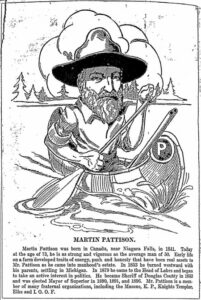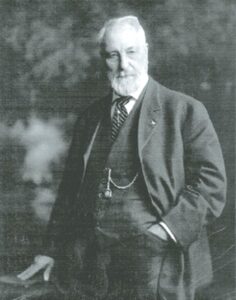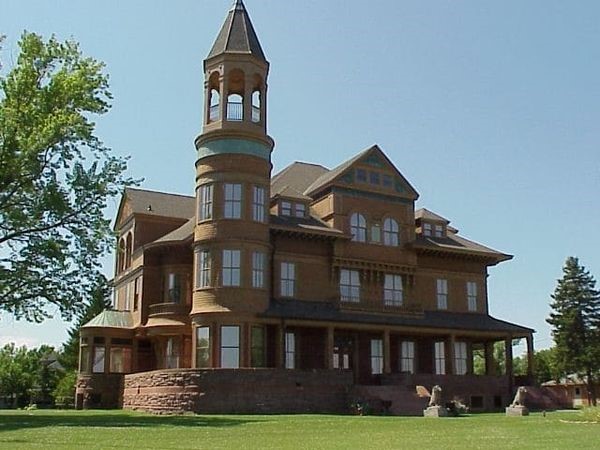 This historical sketch appeared in the December 31, 1913, Duluth News Tribune (perfectduluthday.com). |
 Simeon Thayer when he was Martin Pattison, entrepreneur, politician and philanthropist. |
The Martin Pattison affectionately depicted in the 1913 cartoon above was born as Simeon Martin Thayer in southern Ontario, on January 17, 1841, to Simeon Martin Thayer Sr. and Emmarilla Pattison. And by either name, he was a direct descendant of Stukely and Juliana Westcott in the tenth generation: Simeon Martin Thayer (later Martin Pattison)10, Emmafilia Pattison9, Amy Franklin York8, Stephen York7, Mary Bliven6, Freelove Barker5, Freelove Bliss4, Damaris Arnold3, Damaris Westcott2, Stukely Westcott1. Some of his exploits would make the ancestors proud and some of his doings … well, see for yourself.
When Simeon was around 11 years old, his family moved from Canada to Sanilac County, Michigan. After working in a logging camp for about 10 years and partnering in the lumber business near Minden with Joseph Murdock, Thayer married Murdock’s sister Isabelle Murdock on August 7, 1869, and welcomed their first child five months later. Two years later (1871), Thayer was elected to the Michigan State Legislature. But the following year, things went a bit strange. On April 30, 1872, Simeon Martin Thayer went to Port Huron on business and disappeared, leaving behind his wife and two children.
Coincidentally, at the same time also disappearing from Minden was his wife’s sister 18-year-old Martha Murdock and cash from the Thayer-Murdock lumber business. As the story goes, Thayer became Martin Pattison living in Marquette; Martha joined him and the couple lived as Martin and Martha Pattison until Martha’s death in 1877. (There is no marriage record for Pattison and this “second wife.”)
In 1879 he married Grace E. Frink at Marquette, Michigan. Grace Emma Frink used the surname “Pattison” and she and Simeon had eight children who also used the surname “Pattison.”
The Pattisons moved to Wisconsin, settled in Superior, and Mr. Pattison established a logging business along the Black River. Selling his lumber interests, he explored for iron ore on the Vermilion Range. As a result of his efforts, he located the famous Chandler and Pioneer mines.

Pattison’s success brought him great wealth. In 1880, he built a 42-room Victorian-style mansion, called Fairlawn, which still stands and was once the home of the Douglas County (Wisconsin) Historical Museum.
As the story goes, in exchange for keeping Pattison’s double life secret, his former partner/brother-in-law Joseph Murdock successfully demanded money for his sister Isabelle and two children. Then, when Pattison became very wealthy and famous, Murdock again demanded and successfully secured a legal divorce (June 1890) for his sister, plus financial settlement. And the granting of the divorce was the key to a reporter breaking the story in 1890 of Pattison’s double life, though the publicity didn’t really affect Pattison’s reputation.
Community-minded, he had served as Superior’s sheriff (1885-86) and Superior’s mayor three times. He was also a real estate dealer. In 1917, Pattison learned of a plan to build a power dam on the Black River. He secretly purchased 660 acres and gave the land to the people of Wisconsin for a state park in 1918. By the end of the year Mr. Pattison had died.
In 1935, the Civilian Conservation Corps labored to transform this area into Martin Pattison State Park, one of Wisconsin’s finest parks. Thanks to his foresight and generosity the public is able to enjoy this place of wondrous beauty. Remains of his logging camp can still be seen today from the park’s Logging Camp Trail.
Sources:
Pattison Genealogy: Jeff Westcott, SSWDA Registrar/Genealogist
Michigan Biographical Sketches (Lansing, 1924)
Grace Pattison, Pattison, Frink and Allied Families, Genealogical & Biographical (American Historical Society, 1929) calls this individual “Martin Pattison” stating he was christened Simeon Martin Pattison Thayer and adopted his mother’s surname early in life.
